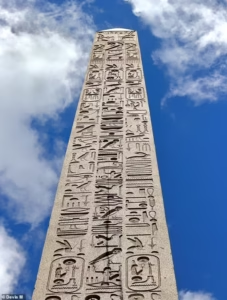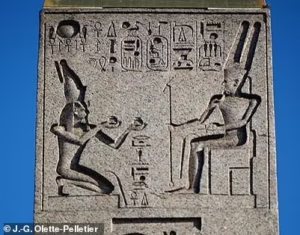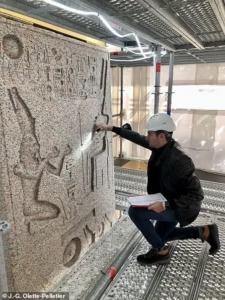The Historical Significance of the Egyptian Obelisk
There are two Luxor Obelisks dating from ancient Egypt. This one, around 75-ft-tall, was moved in the 1830s to the Place de la Concorde in Paris, France
The Egyptian obelisk located in Paris is not only a monument of remarkable architectural achievement but also a representation of deep historical significance. Originally erected in Luxor, Egypt, during the reign of Pharaoh Ramses II around 1250 BCE, this obelisk is one of a pair that stood at the entrance of the Luxor Temple. These towering structures exemplified the architectural prowess of ancient Egyptian civilization, serving both ceremonial and symbolic functions. Obelisks such as this one were monumentally significant within their cultural context, often commemorating victories, divine favor, and the perpetual nature of the pharaoh’s reign.
The tale of how this obelisk journeyed fro
m the sands of Egypt to the heart of Paris is rich with historical intrigue. In 1833, the obelisk was gifted to France by the Egyptian viceroy Muhammad Ali Pasha, reflecting the diplomatic relations and cultural exchanges that were emerging in the 19th century. Following its transportation to France, the obelisk was erected on the Place de la Concorde in 1836, where it remains a prominent feature of the Parisian landscape. The installation of the obelisk in Paris marked not only a triumph of engineering but also an emblem of French imperial ambition and the connections established with ancient cultures.
Discovery of the Secret Messages
The revelation of the secret messages inscribed on the Egyptian obelisk in Paris marked a significant breakthrough in the field of historical research. A dedicated team of scientists employed advanced imaging techniques to uncover these hidden elements. Among the methods utilized, high-resolution photography played a crucial role in capturing the minute details that were previously obscured by wear and environmental factors.
In addition to photography, researchers also used multispectral imaging, which allows for the analysis of materials across different wavelengths. This technique was particularly effective in differentiating between the colors and textures of the inscriptions, thereby illuminating faded markings that have long gone unnoticed. By analyzing these images, scientists were able to discern patterns and symbols that hinted at deeper meanings embedded within the obelisk’s inscriptions.
Textual analysis further complemented these imaging technologies, as specialists deciphered the characters inscribed on the stone. This process involved comparing the obelisk’s inscriptions to known texts from ancient Egypt, enabling researchers to contextualize the messages and understand their significance. The motivation driving this scientific endeavor stemmed from the desire to unveil the mysteries surrounding this historical artifact, previously overshadowed by its majestic stature.The excitement within the academic community surrounding the discovery is palpable. Scholars believe that these hidden messages could provide invaluable insights into the cultural and historical connections between ancient Egypt and France. This endeavor not only adds a new dimension to our understanding of the obelisk itself, but it also opens doors to further inquiries into the symbolic meanings attached to the engravings. As the research progresses, the potential implications may reshape our comprehension of historical narratives linked to this remarkable monument.
Decoding the Seven Messages: What They Reveal
The Egyptian obelisk located at the Place de la Concorde in Paris is not merely an architectural highlight; it serves as a significant historical artifact laden with messages from the past. Each of the seven secret messages inscribed upon its surface provides insights into the social, political, and spiritual dynamics of ancient Egyptian civilization, offering contemporary audiences a deeper appreciation of history. One such message recounts the reign of Pharaoh Ramses II, emphasizing his military conquests and achievements. This inscription not only glorifies the Pharaoh’s accomplishments but serves as a reminder of the centralized power structures of ancient Egypt.
Another message reflects the religious fervor of the time, describing the connection between Pharaoh and the divine. It reveals how the Egyptians perceived their rulers as intermediaries between the gods and themselves, an aspect critical to understanding their culture and societal organization. This divine connection set the foundation for the monumental projects undertaken during that era, showcasing the importance of religion in shaping public life.
Implications for Future Research and Preservation
The revelations surrounding the Egyptian Obelisk in Paris present a vital opportunity for future archaeological studies and the preservation of cultural heritage. As researchers continue to decode the hidden messages etched onto the obelisk, the implications for understanding ancient civilizations become increasingly significant. The ancient texts, though centuries old, serve as valuable resources that can inform contemporary scholarship on social, political, and religious structures of their time.
Moreover, the obelisk is a testament to the enduring nature of human creativity and communication. This emphasizes the necessity for ongoing research to explore similar artifacts in diverse locations. Other historical sites across the globe may harbor comparable inscriptions and messages that are yet to be uncovered. The possibility of new findings points to a rich landscape of archeological potential that could further illuminate historical narratives. As excavation techniques evolve, the likelihood of uncovering additional texts or artifacts increases, creating a critical window for advancing our understanding of ancient societies.
Technology plays a pivotal role in this endeavor. Modern imaging techniques such as 3D scanning and digital reconstruction are revolutionizing the way scholars engage with historical artifacts. Such technologies not only allow for meticulous analysis of existing sites but can also facilitate virtual explorations, making ancient structures accessible for educational purposes. By integrating technology with traditional methodologies, researchers can preserve the integrity of sites while uncovering hidden mysteries.
Preserving the Egyptian Obelisk and sites with similar significance is essential, not only for academic research but also for cultural education and the public’s enrichment. Safeguarding these historical legacies ensures future generations can engage with and learn from our collective past, fostering a deeper appreciation for the intricate tapestry of human history.





